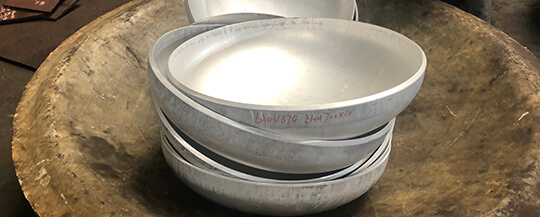Welding
Although aluminum-magnesium alloy has good welding performance, it has good thermal conductivity, large linear expansion coefficient, and cracks and pore defects during welding. How to ensure good welding quality and mechanical properties and increase welding efficiency is the key to the manufacture of large thick-walled aluminum alloy pressure vessels.
Welding procedure qualification Before welding pressure vessels, the welding procedure qualification shall be carried out according to NB/T 47014-2011 "Welding Procedure Qualification for Pressure Equipment", and it is qualified.
Welding materials
Welding wire is an important factor that affects the weld metal composition, structure, weld metal and near seam area thermal crack resistance, corrosion resistance and mechanical properties. The welding wire should be such that the tensile strength of the welded joint is not lower than the lower limit of the base metal standard, the corrosion resistance or plasticity is not lower than the base metal, and it has good welding process performance. Manual argon arc welding wire selects ER5183, Φ5mm; melting pole automatic argon arc welding wire selects ER5183, Φ4mm; materials should meet the requirements of NB/T 47018-2017 "Technical Conditions for Ordering Welding Materials for Pressure Equipment" The purity of argon gas is ≥99.99%.
Welding process measures
Before welding, use acetone to remove greasy dirt and substances harmful to welding quality within 50mm on both sides of the groove and use mechanical methods to clean it.
Clean the oxide film and other harmful impurities until the metallic luster is exposed. Use the welding wire in time after it is clean and dry. After cleaning, it should be welded in time, and the slag and oxide on the surface of the weld bead should be cleaned between layers. The interval between cleaning and welding is ≤24h, otherwise it should be cleaned again. The welding adopts multi-layer and multi-pass non-swing welding, and the appropriate current and welding speed are used to control the heat input.
Preheat 100℃—120℃ before welding. Welding adopts manual argon arc welding (GTAW) double-sided vertical welding bottoming and melting pole automatic argon arc welding
(GTMW) The welding method of the cover surface, the thickness of the double-sided vertical welding bottom welding joint is controlled to be 8mm-10mm, and the interlayer temperature is strictly controlled to 100℃-150℃, so that the weld pool can complete the crystallization process within a reasonable temperature range. So as to obtain better welding quality and mechanical properties.
The distance between the contact tip and the workpiece is 15mm.
When welding, it is necessary to ensure that the welding wire always walks in the 1/3 of the front section of the welding pool. Use the welding ribbon to move the molten pool instead of the molten pool to drag the welding wire forward to avoid defects such as incomplete penetration and non-fusion between weld layers.
At the beginning and end of welding, arc start and stop plates should be used to avoid defects such as incomplete penetration and lack of fusion in the weld.
Welding rework
Welding seams with excessive defects should be repaired, analyze the causes of defects, formulate scientific and reasonable welding repair procedures, and assign
Welders with good welding skills should perform repairs. The number of repairs for the same part (referring to the part where the welded filler metal overlaps) should not exceed two, and the repairs for more than two times should be approved by the technical person in charge.
Welding test board
The welding test plate is the same brand, state and specification as the aluminum plate for the container. It is attached to the first tube section, and the extension of the first longitudinal seam is
The tube section is welded at the same time. Immediately send the test plate for inspection after welding, and process the sample according to the regulations and carry out tensile (305MPa), bending, and impact tests (20J, 22J, 26J), and it is qualified.
Non-destructive testing
Class A and B welded joints shall be carried out in accordance with the provisions of NB/T 47013.2-2017 "Non-destructive testing of pressure equipment Part 2 Radiographic testing"
100% radiographic testing, testing technology level AB, level II qualified. Type A, B, C, D welding joints are in accordance with NB/T 47013.5-
2017 "Non-destructive Testing of Pressure Equipment Part 5 Penetration Testing" stipulates that 100% penetration testing shall be carried out, and the level I is qualified.
Pressure test and air tightness test
After all welding work is completed and passed the final inspection, the product shall be subjected to pressure test and air tightness test according to the requirements of the drawing, and it is qualified.
In conclusion
The application of the rolling method without leaving straight edges solves the problem of straight edges during the forming process of the thick aluminum plate cylinder. Ensure the roundness of the cylinder, control
The amount of misalignment of the ring seam is made, and the welding stress is reduced. Choose the right welding materials, reasonable welding joint groove form, use the appropriate current and welding speed, and adopt the appropriate welding process measures. The welding method of manual argon arc welding (GTAW) double-sided vertical welding and bottoming and melting pole automatic argon arc welding (GTMW) cover surface, obtains better welding quality and mechanical performance improves welding efficiency. The completion of the manufacture of large-scale thick-walled aluminum alloy pressure vessels provides a reference for the design and manufacture of similar products in the future.
